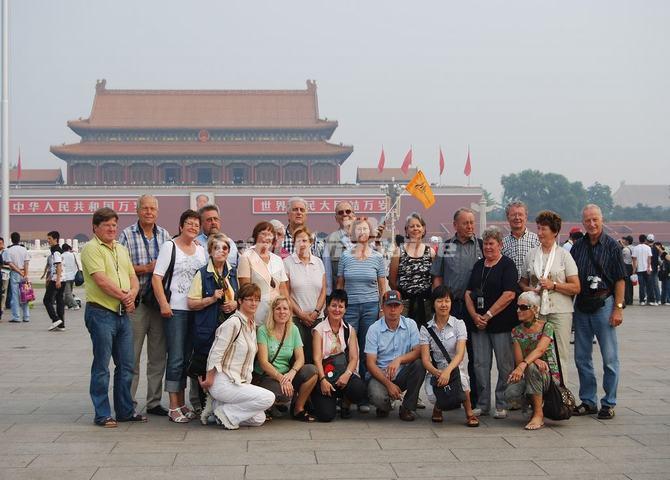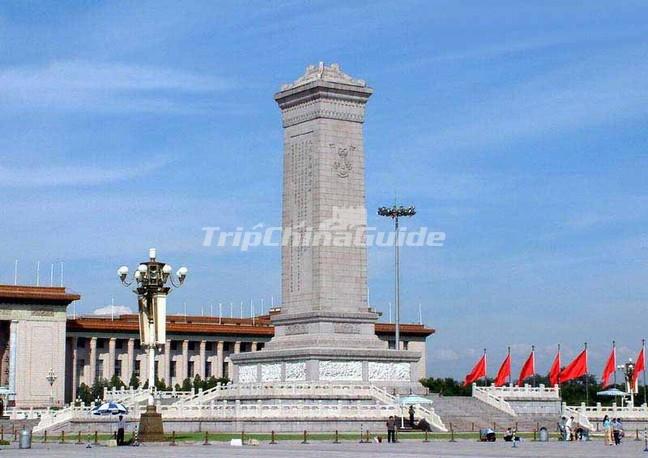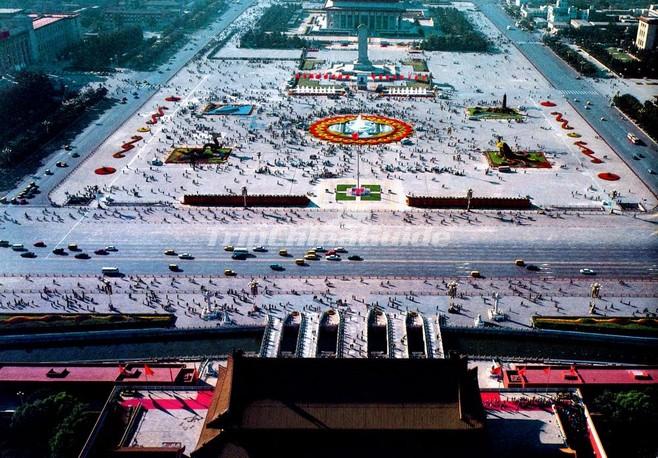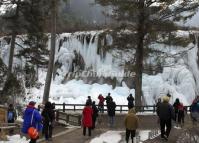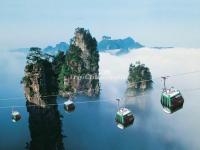Beijing Tiananmen Square Facts
The Tiananmen Square in Beijing, named after the Tiananmen Gate (Gate of Heavenly Peace) located to its north, separating it from the Forbidden City. Tiananmen Square is the largest city square in the world. It has great cultural significance as it was the site of several important events in Chinese history. Mao Zedong proclaimed the founding of the People's Republic in the square on Oct. 1, 1949, an anniversary still observed there.
History of Tiananmen Square
The Tiananmen Gate to the Forbidden City was built in 1415 during the Ming Dynasty. It towards the demise of the Ming Dynasty, heavy fighting between Li Zicheng and the early Qing emperors damaged (or perhaps destroyed) the gate. The Tiananmen Square was designed and built in 1651, and has since enlarged four times its original size in the 1950s.
Near the center of today's square, stood the "Great Ming Gate", the southern gate to the Imperial City, renamed "Great Qing Gate" during the Qing Dynasty, and "Gate of China" during the Republic of China era. Unlike the other gates in Beijing, such as the Tiananmen and the Qianmen, this was a purely ceremonial gateway, with three arches but no ramparts, similar in style to the ceremonial gateways found in the Ming Dynasty Tombs. This gate had a special status as the "Gate of the Nation", as can be seen from its successive names. It normally remained closed, except when the Emperor passed through. Commoner traffic was diverted to two side gates at the western and eastern ends of today's square, respectively. Because of this diversion in traffic, a busy marketplace, called Chessgrid Streets developed in the big, fenced square to the south of this gate.
British and French troops who invaded Beijing in 1860 pitched camp near the gate and briefly considered burning down the gate and the entire Forbidden City. They decided ultimately to spare the palace and to burn instead the emperor's Old Summer Palace. The Qing emperor eventually agreed to let the foreign powers barrack troops – and later establish diplomatic missions – in the area, resulting in the Legation Quarter immediately to the east of the modern square. During the Boxer Rebellion of 1900 the siege badly damaged the office complexes and several ministries were burnt down. In the conflict's denouement, the area became a space for foreign troops to assemble their armies and horses.
In the early 1950s, the Gate of China was demolished, allowing for the enlargement of the square. In November 1958 a major expansion of Tiananmen Square started, which was completed after only 11 months, in August 1959. This followed the vision of Mao Zedong to make the square the largest and most spectacular in the world, and intended to hold over 500,000 people. In that process, a large number of residential buildings and other structures have been demolished. On its southern edge, the Monument to the People's Heroes has been erected. Concomitantly, as part of the Ten Great Buildings constructed between 1958–59 to commemorate the ten-year anniversary of the People's Republic of China, the Great Hall of the People and the Revolutionary History Museum (now National Museum of China) were erected on the western and eastern sides of the square.
The year after Mao's death in 1976, a Mausoleum was built near the site of the former Gate of China, on the main north-south axis of the square. In connection with this project, the square was further increased in size to become fully rectangular and being able to accommodate 600,000 persons. The urban context of the square was altered in the 1990s with the construction of National Grand Theatre in its vicinity and the expansion of the National Museum.
Configuration
Used as a massive meeting place since its creation, its flatness is contrasted by the 38-meter high Monument to the People's Heroes, and the Mausoleum of Mao Zedong. The square lies between two ancient, massive gates: the Tiananmen to the north and the Zhengyangmen, better known as Qianmen to the south. Along the west side of the Square is the Great Hall of the People. Along the east side is the National Museum of China (dedicated to Chinese history predating 1919). Changan Avenue, which is used for parades, lies between the Tiananmen and the Square. Trees line the east and west edges of the Square, but the square itself is open, with neither trees nor benches. The Square is lit with large lampposts which are fitted with video cameras. It is heavily monitored by uniformed and plain clothes policemen.
Attractions around/in Tiananmen Square
1. Tiananmen Tower
At the north end of the Square is Tiananmen Tower. Initially built in 1417 during the Ming Dynasty (1368 A.D.- 1644 A.D.), the Square was the front door of the Forbidden City. The most important use of it in the past was to declare in a big ceremony to the common people who became the emperor and who became the empress. Until 1911 when the last feudal kingdom was over, no one could enter the Tower except for the royal family and aristocrats.
2. Monument to People's Heroes
The Monument to the People's Heroes is a ten-story obelisk that was erected as a national monument of the People's Republic of China to the martyrs of revolutionary struggle during the 19th and 20th centuries. It is located in the southern edge of Tiananmen Square in Beijing, to the north of Mausoleum of Mao Zedong. The monument was built in accordance with a resolution of the First Plenary Session of the Chinese People's Political Consultative Conference adopted on November 30, 1949, with construction lasting from August 1952 to May 1958. The architect of the monument was Liang Sicheng, with some elements designed by his wife, Lin Huiyin.
3. Great Hall of the People
The Great Hall of the People is located at the western edge of Tiananmen Square, Beijing, People's Republic of China (PRC). It is used for legislative and ceremonial activities by the PRC and the Communist Party of China. It functions as the meeting place of the National People's Congress, the Chinese parliament.
4. Memorial Hall of Chairman Mao
The Chairman Mao Memorial Hall commonly known as the Mausoleum of Mao Zedong or the Mao Mausoleum, it is the final resting place of Mao Zedong, Chairman of the Politburo of the Communist Party of China from 1943 and the Chairman of the Communist Party of China from 1945 until his death in 1976. This highly popular attraction is located in the middle of Tiananmen Square in Beijing, the capital of China. It stands on the previous site of the Gate of China, the southern (main) gate of the Imperial City during the Ming and Qing dynasties.
5. National Museum of China
The National Museum of China flanks the eastern side of Tiananmen Square in Beijing, China. The museum's mission is to educate about the arts and history of China. It is directed by the Ministry of Culture of the People's Republic of China. Inside the Chinese Revolutionary Museum are a lot of material objects, pictures, books and models to present the development of modern China. The Chinese History Museum shows a large number of cultural relics illustrating the long history and glorious culture of China from 1,700,000 years ago to 1921 when the last emperor left the throne.
How to Get
1. Subway: Take Subway Line 1 and get off at Tiananmen East or Tiananmen West Station; or take Subway Line 2 and get off at Qianmen Station. Get out from Exit A or B and walk North.
2. Take bus 2, 5, 20, 120, 126, or 210 and get off at Tiananmen Guangchang Dong or Tiananmen Guangchang Xi Station.
Recommended China Tour Packages
-
5-day Chengdu and Jiuzhaigou Tour
-
3-day Chengdu Panda & Mount Qingcheng Tour
-
15-day China Wonders Tour







